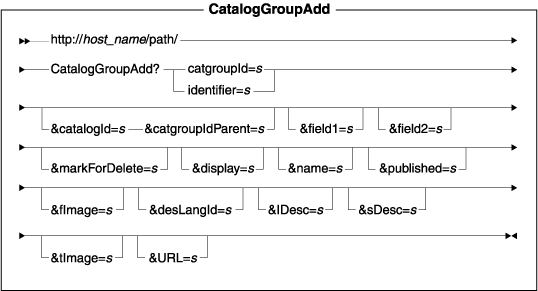CatalogGroupAdd URL
This URL adds a new catalog group and its description, and adds a relationship between the new catalog group and the store.
URL structure
- http:// host_name/path/
- The fully qualified name of your WebSphere Commerce Server and the configuration path.

Parameter values
- catgroupId
- (Required) The reference number of the catalog group. The catalog group ID creates a language-dependent catalog group description on a created or existing catalog group. You must specify either catgroupId or identifier.
- identifier
- (Required) The external identifier of the catalog group. You must specify either identifier or catgroupId.
- catalogId
- The ID of the catalog that the new catalog group belongs to.
- catgroupIdParent
- The parent catalog group of the newly created catalog group.
- field1
- A customizable field.
- field2
- A customizable field.
- markForDelete
- Indicates if the catalog group is marked for deletion.
- display
- Reserved for IBM internal use.
- name
- The language-dependent name of the catalog group.
- published
- Indicates whether or not this catalog group should be displayed for the language indicated by the descLangId: 0= no, and 1= yes.
- fImage
- The full image path for the catalog group.
- descLangId
- The description of the language's reference number.
- lDesc
- The long description of the catalog group.
- sDesc
- The short description of the catalog.
- tImage
- The thumbnail image path for the catalog group.
- URL
- The URL to be called when the command completes successfully.
Example 1
The following example creates a catalog group, with testCatalogGroup2 as the identifer and NoLangSpecified as the name, in the logon language:
http://host_name/webapp/wcs/stores/servlet/CatalogGroupAdd?identifier= testCatalogGroup2&keyword=a keyword&field1=hello&field2=world&display= TestJSP&name=NolangSpecified&markForDelete=0&lDesc=long description&sDesc=short description&URL=LogonForm
Example 2
The following example creates a category, with TestCatalogGroup3 as the identifier and NoName1 as the name, in the logon language. The newly created catalog group will be assigned as a subcategory of catalog group 9000 in catalog 7002:
http://host_name/webapp/wcs/stores/servlet/CatalogGroupAdd?identifier= TestCatalogGroup3&field1=hello&field2=world&display=TestJSP&name= NoName1&markForDelete=0&catalogId=7002&catgroupIdParent=9000&URL=LogonForm
Example 3
The following example creates a description, with testCatalogGroup2 as the name, for catalog group 10002:
http://host_name/webapp/wcs/stores/servlet/CatalogGroupAdd?catgroupId= 10002&display=TestJSP2&name=testCatalogGroup2&descLangId=-2&URL=LogonForm
Example 4
The following example creates a catalog group, with DemoStoreCatGroup1 as the identifier and NolangSpecified as the name, in the logon language:
http://host_name/webapp/wcs/stores/servlet/CatalogGroupAdd?identifier= DemoStoreCatGroup1&field1=hello&field2=world&display=TestJSP&name= NolangSpecified&markForDelete=0&URL=LogonForm
Example 5
The following example creates a catalog group, with addGroup12 as the identifier and catGroup11 as the name:
http://host_name/webapp/wcs/stores/servlet/CatalogGroupAdd?identifier= addGroup12&field1=hello&field2=world&display=catGroup11&name= catGroup11&descLangId=-1&URL=LogonForm
Example 6
The following example creates a catalog group, with DemoStoreCatGroup2 as the identifier and catGroup11 as the name:
http://host_name/webapp/wcs/stores/servlet/CatalogGroupAdd?identifier= DemoStoreCatGroup2&field1=hello&field2=world&display=catGroup11&name= catGroup11&descLangId=-1&URL=LogonForm
Behavior
- If catgroupIdParent and catalogID are supplied, then the newly created catalog group will be a subcategory of the cagroupIdParent (a new row in the CATGRPREL table in the database will be added).
- If the catgroupId is supplied and a new language ID is supplied, then a description for the catalog group will be created. However, we recommend that you use the CatalogGroupUpdate command when creating or updating a catalog group description.
Exception condition
Duplicate key (identifier) has already been used.
Related concepts
Catalog subsystem
Related reference
CatalogGroupDelete URL
CatalogGroupMove URL
CatalogGroupUpdate URL
TopCatalogGroupAdd URL
TopCatalogGroupDelete URL
CatGroupRelAdd URL
CatGroupRelDelete URL
Catalog subsystem URLs